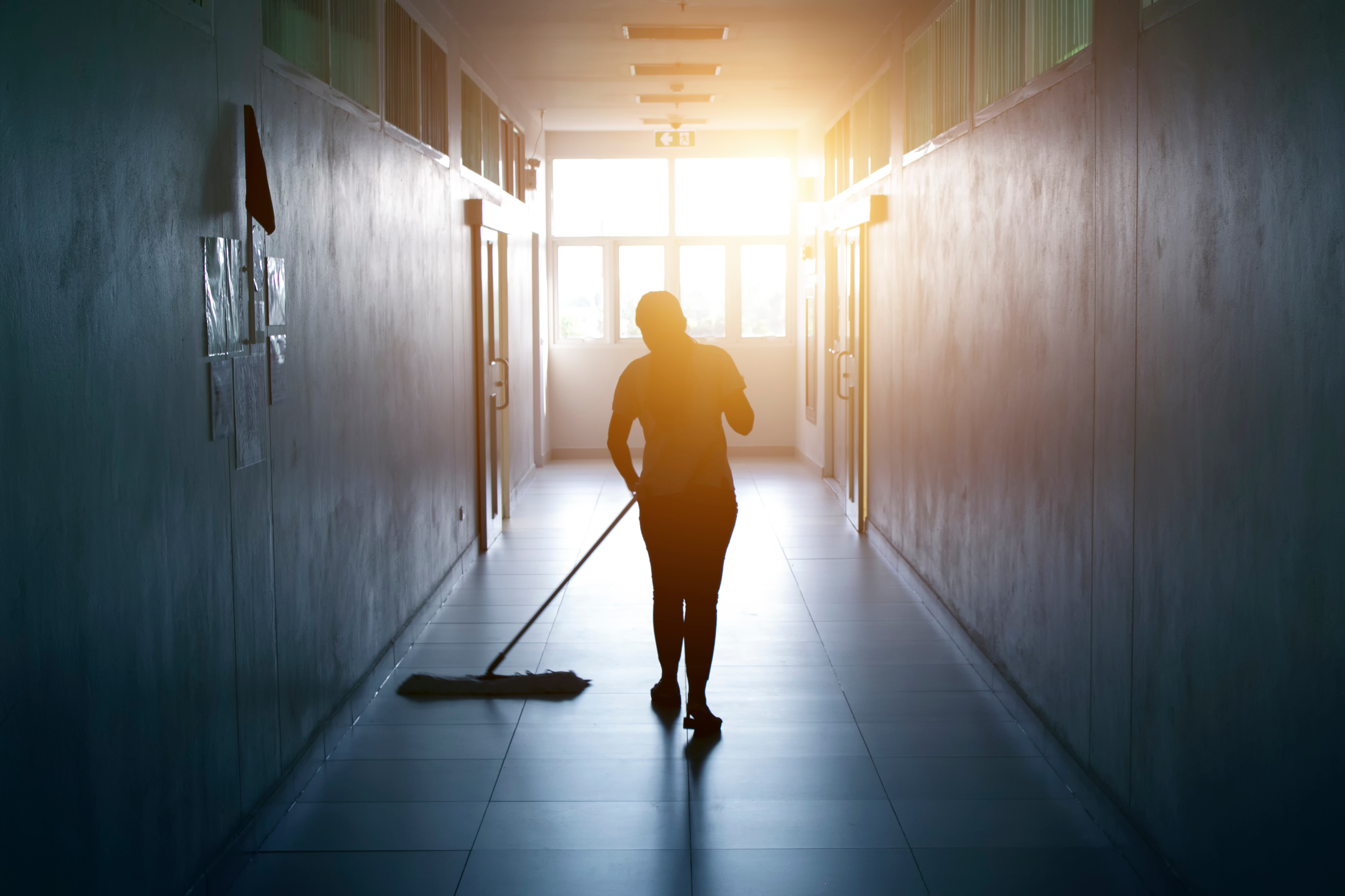From K-12 to higher education, maintaining a clean and safe school environment is essential to protect the health and well-being of students, teachers, and staff. However, school maintenance staff often face significant challenges–from ongoing staffing shortages to the rising cost of labor–that make it difficult to fulfill rising expectations for school upkeep and cleanliness.
In this blog, we will explore some of the most common challenges school janitorial staff face, and how to address these challenges effectively
1. Jobsite Hazards
Keeping schools clean might not sound like a hazardous job, but, as with any manual labor, it comes with its own risks of injury. Slippery floors, chemicals, heavy lifting, and malfunctioning equipment are just a few examples of potential hazards in school environments.
In addition, repetitive movements required by many cleaning activities can lead to overuse injuries. These potential hazards not only threaten the well-being of maintenance teams but can also lead to injury-induced absences that can disrupt your cleaning operations.
Solution: Prioritize Safety Training and Equipment
To mitigate the risks associated with jobsite hazards, school administrators and janitorial management teams should prioritize safety training and provide the appropriate safety equipment — such as eye protection for hazardous cleaning solutions, reflective vests for visibility, and ear plugs for operating loud machinery — to their staff. Comprehensive safety training programs, especially for new team members, can help ensure that janitors and other maintenance workers follow best practices to protect themselves from common hazards.
Another way to reduce the risk of accidents and injuries is to offload the more repetitive and injury-prone work. Vacuuming, for example, is a common contributor to workplace injury. Implementing automated solutions in this area can help protect staff from injury while also freeing them up to focus on higher-value work.
2. Staff Retention
Like many industries, the cleaning industry has continued to face significant labor shortages, making it more difficult than ever for schools to recruit and retain skilled staff. High turnover rates among school maintenance staff create inconsistent cleaning standards and add to the workload of the remaining staff members, leading to low morale and high rates of burnout.
Solution: Assign More Fulfilling Responsibilities
To improve retention, maintenance management teams can take proactive steps to make the school cleaning job more engaging and fulfilling for their janitorial staff. For example, one approach is to offload repetitive and labor-intensive tasks, such as vacuuming and mopping floors, with help from new technologies.
This allows your team to focus on more rewarding responsibilities, such as deep cleaning, working on sustainability initiatives, and managing cleaning equipment – even robots. By offloading the most mundane aspects of the job and providing custodial staff with opportunities for skill development and growth, schools can increase staff satisfaction, reduce turnover rates, and ultimately improve cleaning quality and thoroughness.
3. Increasing Cleanliness Expectations
While the pandemic may no longer be at the forefront of everyone’s minds, the lasting impact of COVID-19 on cleaning expectations is undeniable. In schools, there remains a heightened emphasis on cleanliness and hygiene. Spot cleans and skipping tasks are simply not an option. Instead, students, staff, and parents now hold higher expectations for the cleanliness of schools. These high standards, compounded with ongoing labor shortages, make it challenging for school staff to keep up.
Solution: Automate Your Cleaning Operations
To meet these heightened cleanliness expectations, school administrators are increasingly turning to automated cleaning solutions to augment the capabilities of their staff and deliver a consistent, high-quality clean.
Automated cleaning technologies, such as robotic vacuums and floor scrubbers, can effectively take on some of the most time-consuming cleaning tasks, freeing up staff to focus on the tasks that require a human touch and attention to detail, like deep cleaning, sanitizing, and disinfecting.
4. Rising Cost of Labor
Keeping up with cleaning expectations seems like an impossible task that requires hiring more staff–a major challenge in a tight labor market. As the demand for cleaning and maintenance services has increased, the cost of hiring and retaining labor has been on the rise. This poses a challenge for schools with limited resources and budgets.
Solution: Prioritize Fixed-Cost Resources
To manage cleaning and maintenance budgets effectively, school administrators don’t necessarily need to hire more staff. Instead, schools can increase the effectiveness and satisfaction of their existing staff by empowering janitors with the help of cleaning technologies.
Implementing efficient and reliable autonomous cleaning solutions can help schools optimize their cleaning operations in the face of increasing labor costs. Compared to traditional labor costs, which increase over time, autonomous cleaning solutions remain a fixed cost over time, which helps school administrators plan and make best use of their spend.
By strategically incorporating robotic cleaning solutions and other automated systems, schools can allocate their resources more effectively and achieve a higher level of cleanliness–while also staying mindful of their budgets.
Final Thoughts
While schools face significant challenges when it comes to managing cleaning requirements, these challenges are not insurmountable. With the help of innovative solutions like automated cleaning technologies, schools can create cleaner and safer environments for their communities.
Implementing these solutions not only enhances the well-being of students and staff, but also helps schools get the most value out of their resources. By focusing on proactive strategies, schools can overcome staffing challenges and ensure a safe and healthy learning environment.
Want to hear more? Learn how one school district has saved hundreds of man-hours by integrating Whiz, the commercial robot vacuum, into their cleaning operations. Read, or watch, the case study here.






